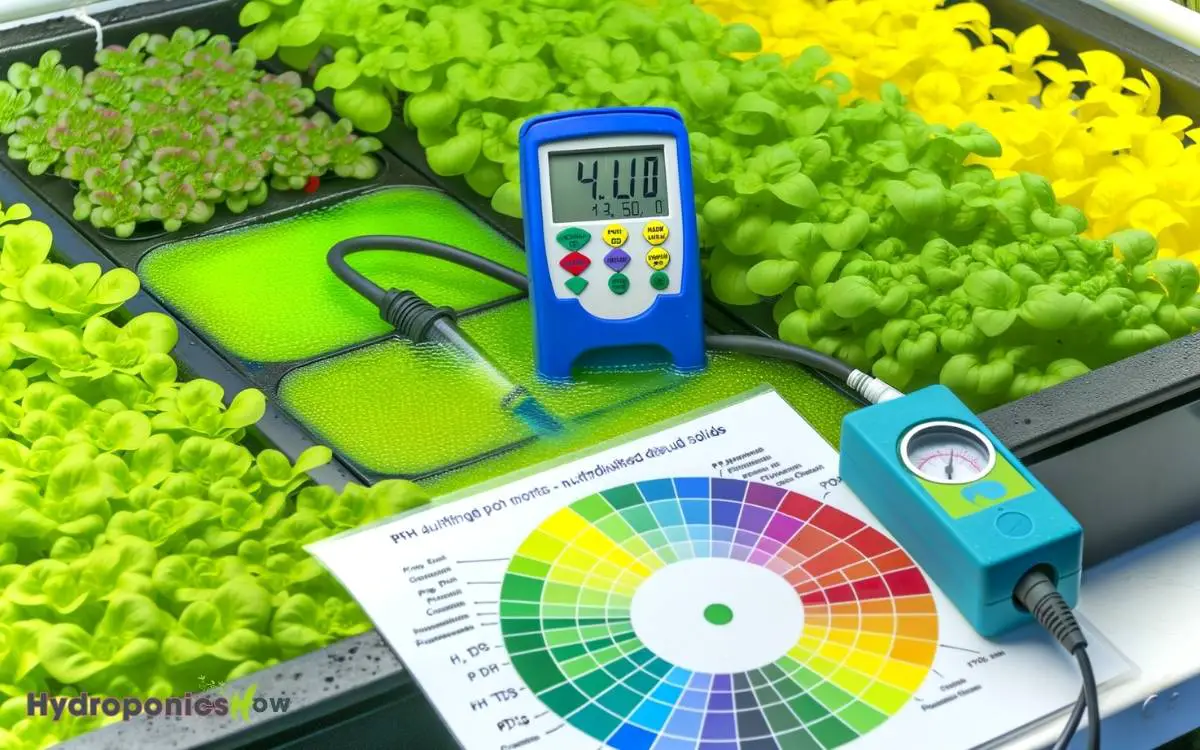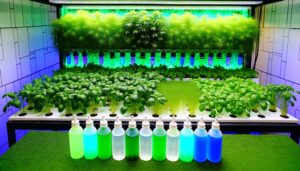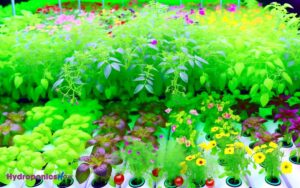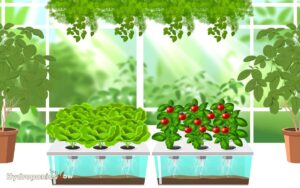Best Chart of Essential pH and TDS Levels for All Hydroponics Garden Plants
Maintaining the proper pH and TDS levels is crucial for hydroponic garden success. The ideal pH range for most hydroponic plants is 5.5-6.5, with precise targets varying by plant type.
Leafy greens thrive with a pH of 5.5-6.5 and TDS of 560-840 ppm, while herbs prefer a pH of 5.5-6.5 and TDS of 800-1200 ppm. Root vegetables require a slightly higher pH of 6.0-6.5 and TDS of 1,200-2,000 ppm.
Fruiting plants need tailored pH and TDS levels for optimal growth. Continuous monitoring and adjustment are key for preventing nutrient imbalances and ensuring robust plant health. For detailed guidelines and troubleshooting tips, continue exploring.

Key Takeaways
Understanding Ph Levels
Understanding pH levels is essential for optimizing nutrient uptake and overall plant health in hydroponic systems. The pH scale, ranging from 0 to 14, measures the acidity or alkalinity of the nutrient solution.
Ideal pH levels for hydroponic gardening typically fall between 5. 5 and 6. 5, as this range guarantees maximum solubility and availability of essential nutrients. Maintaining the appropriate pH within this range helps plants absorb nutrients more efficiently, promoting healthier growth and higher yields. In addition to pH balance, growers must also consider how much water hydroponic plants need, as both over- and under-watering can impact nutrient uptake. Regular monitoring and adjustments ensure an optimal growing environment for thriving plants.
Deviations outside this range can lead to nutrient lockout or toxicity, adversely affecting plant growth. Continuous monitoring and adjustment of pH levels are vital. Utilizing pH meters and pH adjustment solutions allows precise control.
Research indicates that maintaining ideal pH levels can enhance nutrient absorption efficiency by up to 20%, significantly boosting plant growth and yield in hydroponic systems.
Role of TDS in Hydroponics
While maintaining essential pH levels is fundamental, monitoring Total Dissolved Solids (TDS) is equally vital for ensuring balanced nutrient concentrations in hydroponic systems.
TDS represents the total concentration of dissolved ions, important for plant health and growth. High or low TDS readings can indicate nutrient imbalances, potentially leading to deficiencies or toxicities.
Key roles of TDS in hydroponics include:
- Nutrient Availability: Ensures sufficient nutrients are present for ideal growth.
- Water Quality: Helps detect impurities that can impact plant health.
- Nutrient Solution Strength: Guides adjustments to the nutrient mix for specific plant stages.
- System Maintenance: Assists in identifying the need for water changes or system flushing.
Accurate TDS management is essential for successful hydroponic gardening.
Ph and TDS Monitoring Tools
For precise management of nutrient solutions in hydroponics, specialized pH and TDS monitoring tools are indispensable.
Accurate monitoring guarantees ideal nutrient absorption, leading to healthier plant growth. Commonly used instruments include digital pH meters, pH test strips, and TDS meters.
Digital pH meters provide quick, precise readings and are often calibrated for enhanced accuracy. pH test strips offer a cost-effective alternative but may lack precision.
TDS meters, meanwhile, measure the total dissolved solids in the solution, indicating nutrient concentration.
| Tool | Description |
|---|---|
| Digital pH Meter | Highly accurate, requires regular calibration |
| pH Test Strips | Economical, less precise |
| TDS Meter | Measures nutrient concentration, easy to use |
These tools are essential for maintaining the delicate balance required for successful hydroponic systems.
Leafy Greens Ph and TDS
For ideal growth of leafy greens in hydroponic systems, maintaining a pH level between 5.5 and 6.5 is crucial.
The perfect Total Dissolved Solids (TDS) range for these plants is typically between 560 to 840 ppm, ensuring adequate nutrient absorption.
Precise control of these parameters can greatly enhance the yield and quality of leafy greens.
Optimal Ph Levels
Maintaining an ideal pH range of 5.5 to 6.5 is crucial for the healthy growth of leafy greens in hydroponic systems. This pH range guarantees maximum nutrient availability and uptake, preventing deficiencies and toxicities that can hinder plant development.
Key considerations for maintaining this pH range include:
- Regular Monitoring: Utilize pH meters and test strips to frequently check and adjust the pH levels.
- pH Adjusters: Employ pH up and pH down solutions to sustain the desired pH balance.
- Stable Water Source: Ensure the water used is stable and contributes minimally to pH fluctuations.
- Buffer Solutions: Incorporate buffering agents that help stabilize the pH levels, reducing the need for constant adjustments.
Ideal TDS Range
Achieving an ideal TDS range of 800 to 1,200 ppm is essential for optimizing nutrient concentrations and promoting robust growth in leafy greens cultivated through hydroponics.
This range guarantees an ideal balance of macro and micronutrients, enhancing photosynthetic efficiency and cellular development.
Monitoring TDS levels within this specified range prevents nutrient deficiencies or toxicities, important for maintaining plant health.
Studies indicate that leafy greens such as lettuce, spinach, and kale exhibit enhanced growth rates and improved yield quality when sustained within this TDS spectrum.
Regular calibration of TDS meters and consistent nutrient solution adjustments are imperative to maintain this balance.
Accurate tracking and fine-tuning of TDS levels can have a significant impact on the overall productivity and vitality of hydroponic leafy greens.
Fruiting Plants Ph and TDS
Optimizing pH and TDS levels is crucial for the successful growth and productivity of fruiting plants in hydroponic systems. Maintaining precise pH levels guarantees nutrient availability, while ideal TDS levels indicate appropriate nutrient concentration.
For fruiting plants, the recommended pH and TDS ranges are as follows:
- Tomatoes: pH 5.5-6.5, TDS 1400-3500 ppm
- Strawberries: pH 5.5-6.2, TDS 1260-1540 ppm
- Peppers: pH 5.8-6.3, TDS 1750-2450 ppm
- Cucumbers: pH 5.5-6.0, TDS 1190-1750 ppm
Monitoring and adjusting these parameters can greatly enhance fruit development and yield. Utilizing accurate pH and TDS meters is crucial to maintain these ideal conditions, ensuring healthy, vigorous plants and bountiful harvests.
Herbs Ph and TDS
Just as with fruiting plants, precise pH and TDS levels are essential for the ideal growth of herbs in hydroponic systems. Ideal pH levels for most herbs range between 5.5 and 6.5, guaranteeing efficient nutrient uptake and robust growth.
TDS (Total Dissolved Solids) levels, which measure the nutrient concentration, should typically fall between 800 and 1200 ppm (parts per million) for most herb varieties.
Monitoring and adjusting these parameters is vital; deviations can lead to nutrient deficiencies or toxicities.
For instance, basil thrives at a pH of 5.8-6.2 and TDS of 800-1200 ppm, while mint prefers a pH of 5.5-6.0 and TDS of 700-1000 ppm. Regular testing ensures the health and productivity of your hydroponic herb garden.
Root Vegetables Ph and TDS
Root vegetables in hydroponic systems need a pH range of 6.0 to 6.5 to guarantee peak nutrient uptake.
The ideal TDS range for these crops is between 1,200 and 2,000 ppm, depending on the specific type of root vegetable.
Maintaining a balanced nutrient solution is crucial to prevent deficiencies and promote robust growth.
Ideal Ph Levels
Understanding the best pH levels for root vegetables in a hydroponic system is crucial for maximizing nutrient uptake and overall plant health. Root vegetables such as carrots, radishes, and beets thrive in specific pH conditions.
Maintaining the correct pH guarantees that essential nutrients are available for absorption, preventing deficiencies and promoting robust growth.
Key pH guidelines for root vegetables in hydroponics:
- Carrots: Ideal pH range of 6.0-6.5
- Radishes: Best pH range of 6.0-7.0
- Beets: Optimal pH range of 6.0-7.5
- Turnips: Preferred pH range of 6.0-6.8
Following these pH ranges creates an environment conducive to healthy root development and efficient nutrient uptake, resulting in higher yields and better-quality produce.
Optimal TDS Range
In parallel with maintaining proper pH levels, ensuring the ideal Total Dissolved Solids (TDS) range is vital for the successful growth of root vegetables in hydroponic systems.
Root vegetables such as carrots, radishes, and beets typically thrive within a TDS range of 1,200 to 1,600 ppm (parts per million). This range guarantees the appropriate concentration of essential nutrients, promoting ideal root development and overall plant health.
Monitoring and adjusting TDS levels can prevent nutrient deficiencies or toxicities, which are critical for achieving high yield and quality.
Accurate TDS management, coupled with consistent pH control, forms the foundation of a robust hydroponic setup that maximizes the growth potential of root vegetables.
Nutrient Solution Balance
Maintaining a precise nutrient solution balance is essential for optimizing both pH and TDS levels to guarantee the robust growth of root vegetables in hydroponic systems.
Root vegetables, such as carrots, radishes, and beets, require specific pH and TDS ranges to ensure the best nutrient uptake and growth.
Key parameters include:
- pH Range: Maintain a pH level between 5.8 and 6.2 to maximize nutrient solubility and availability.
- TDS Levels: Target a TDS range of 1,000 to 1,400 ppm to ensure sufficient nutrient concentration.
- Monitoring: Regularly check and adjust pH and TDS levels using reliable meters.
- Nutrient Solutions: Utilize balanced nutrient solutions formulated for root vegetables to prevent deficiencies and promote healthy root development.
Troubleshooting Ph and TDS Issues
Diagnosing pH and TDS issues in hydroponic systems demands a systematic approach to ensure peak nutrient absorption and plant health.
Begin by regularly calibrating pH meters and ensuring they deliver accurate readings. Employ buffer solutions to recalibrate if discrepancies are noted.
For TDS, use a reliable meter and cross-reference readings with ideal ranges for specific plants. Observe symptoms like nutrient lockout or deficiency, which often indicate pH or TDS imbalances.
Correct pH by adding acids or bases, ensuring gradual adjustments. Address high TDS by diluting the nutrient solution with distilled water, while low TDS necessitates nutrient supplementation.
Consistent monitoring and prompt intervention are critical to maintaining an excellent hydroponic environment.
Conclusion
In the intricate world of hydroponics, mastering pH and TDS levels is akin to orchestrating a symphony where each note contributes to the harmony of plant health. Precision in monitoring and adjusting these parameters guarantees lush, verdant foliage and bountiful yields.
Leafy greens, fruiting plants, herbs, and root vegetables each have their own unique requirements, and understanding these nuances transforms a garden into a thriving oasis, resonating with the vibrant pulse of optimized growth and productivity.






